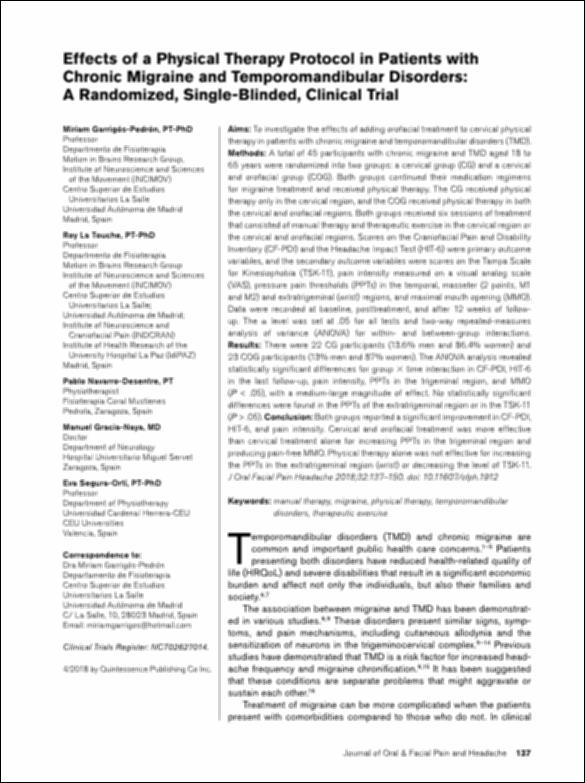Please use this identifier to cite or link to this item:
http://hdl.handle.net/10637/10532Effects of a Physical Therapy protocol in patients with chronic migraine and temporomandibular disorders : a randomized, single-blinded, clinical trial
| Title: | Effects of a Physical Therapy protocol in patients with chronic migraine and temporomandibular disorders : a randomized, single-blinded, clinical trial |
| Authors : | Garrigós Pedrón, Miriam La Touche Arbizu, Roy Navarro Desentre, Pablo Gracia Naya, Manuel Segura Ortí, Eva |
| Keywords: | Cefalalgia - Fisioterapia.; Articulación temporomandibular - Trastornos - Fisioterapia.; Headache - Physical theraphy.; Migraine - Physical theraphy.; Migraña - Fisioterapia.; Temporomandibular joint - Diseases - Physical theraphy. |
| Publisher: | Quintessenz Verlags. |
| Citation: | Garrigós Pedrón, M., La Touche, R., Navarro Desentre, P., Gracia Naya, M. and Segura Ortí, E. (2018). Effects of a Physical Therapy protocol in patients with chronic migraine and temporomandibular disorders : a randomized, single-blinded, clinical trial. Journal of Oral & Facial Pain and Headache, vol. 32, n. 2, pp. 137-150. DOI: https://doi.org/10.11607/ofph.1912 |
| Abstract: | Aims: To investigate the effects of adding orofacial treatment to cervical physical therapy in patients with chronic migraine and temporomandibular disorders (TMD). Methods: A total of 45 participants with chronic migraine and TMD aged 18 to 65 years were randomized into two groups: a cervical group (CG) and a cervical and orofacial group (COG). Both groups continued their medication regimens for migraine treatment and received physical therapy. The CG received physical therapy only in the cervical region, and the COG received physical therapy in both the cervical and orofacial regions. Both groups received six sessions of treatment that consisted of manual therapy and therapeutic exercise in the cervical region or the cervical and orofacial regions. Scores on the Craniofacial Pain and Disability Inventory (CF-PDI) and the Headache Impact Test (HIT-6) were primary outcome variables, and the secondary outcome variables were scores on the Tampa Scale for Kinesiophobia (TSK-11), pain intensity measured on a visual analog scale (VAS), pressure pain thresholds (PPTs) in the temporal, masseter (2 points, M1 and M2) and extratrigeminal (wrist) regions, and maximal mouth opening (MMO). Data were recorded at baseline, posttreatment, and after 12 weeks of followup. The α level was set at .05 for all tests and two-way repeated-measures analysis of variance (ANOVA) for within- and between-group interactions. Results: There were 22 CG participants (13.6% men and 86.4% women) and 23 COG participants (13% men and 87% women). The ANOVA analysis revealed statistically significant differences for group × time interaction in CF-PDI, HIT-6 in the last follow-up, pain intensity, PPTs in the trigeminal region, and MMO (P < .05), with a medium-large magnitude of effect. No statistically significant differences were found in the PPTs of the extratrigeminal region or in the TSK-11 (P > .05). Conclusion: Both groups reported a significant improvement in CF-PDI, HIT-6, and pain intensity. Cervical and orofacial treatment was more effective than cervical treatment alone for increasing PPTs in the trigeminal region and producing pain-free MMO. Physical therapy alone was not effective for increasing the PPTs in the extratrigeminal region (wrist) or decreasing the level of TSK-11. |
| Description: | Este artículo se encuentra disponible en la página web de la revista en la siguiente URL: https://jop.quintessenz.de/index.php?doc=abstract&abstractID=40369 |
| URI: | http://hdl.handle.net/10637/10532 |
| Rights : | http://creativecommons.org/licenses/by-nc-nd/4.0/deed.es |
| ISSN: | 2333-0384. 2333-0376 (Electrónico). |
| Issue Date: | 21-Mar-2018 |
| Center : | Universidad Cardenal Herrera-CEU |
| Appears in Collections: | Dpto. Enfermería y Fisioterapia |
Items in DSpace are protected by copyright, with all rights reserved, unless otherwise indicated.


